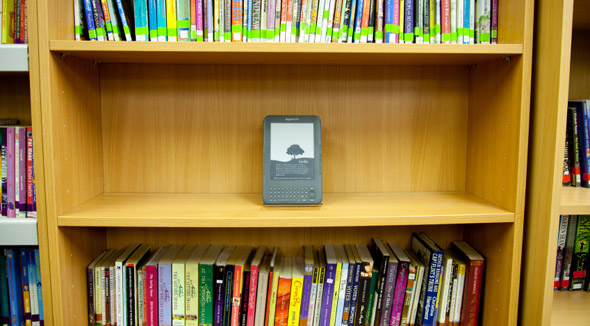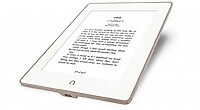
Libraries are at a crossroads when it comes to offering e-books. Major publishers have draconian policies where they sell books to libraries at a 500% markup or impose limitations have 26 checkouts before the library has to buy the book again. In a few short years libraries are spending double or triple the amount on digital and something needs to be done to convince the publishers to ease up. The only way libraries can be saved is throwing down with Amazon.
Amazon currently has a 75% market share in the US and 95% in the United Kingdom when it comes to selling e-books. The Seattle company has the most successful self-publishing program and offers compelling reasons to stay exclusive with them and forgo selling their titles on Apple, Barnes and Noble or Kobo. They pay authors per page read, which amounts to more money than the author would make selling it straight up for $1.00.
Amazon not only sells books on the authors behalf, but they also run their own publishing business. The company has 14 different imprints, such as Thomas & Mercer, 47North, Grand Harbor Press, Two Lions and Waterfall Press. Likely, the biggest imprint right now that is garnering the most attention is Amazon Crossing.
AmazonCrossing, is Amazons translation imprint, and they recently announced it would be committing $10 million over the next five years to publishing more works in translation. “We launched AmazonCrossing five years ago to introduce readers to voices of the world through English-language translations of foreign-language books,” AmazonCrossing’s publisher Sarah Jane Gunter said in a statement. “While we are now one of the largest publishers of translated literature in the United States, translated fiction is still a tiny fraction of new publications.”
AmazonCrossing’s biggest hit so far is probably The Hangman’s Daughter, written in German by Oliver Pötzsch. Its success illustrates how AmazonCrossing capitalizes on its parent company’s global footprint to decide which books to translate. This historical mystery, published by Ullstein Verlag, sold unevenly in German bookstores but managed to gain traction with readers on Amazon’s German site.
The Hangman’s Daughter has sold over a million copies (mostly electronically) in English since it was first published in 2010.
Amazons biggest success when it comes to their own imprint is to capitalize on undeserved niches and fill the void with original works. Sometimes they lure authors away from big publishing houses and in other cases they elevate authors from Kindle Direct Publishing.
I think Amazon should start a distribution system that would allow library branches all over the world to tap into the Kindle e-book ecosystem and offer better deals than the major publishers. The authors would enjoy the added exposure of being in thousands of libraries and garner extra sales.
Currently, Amazon has a multi-year distribution deal with Overdrive, that offers major publishers titles in the Kindle format. This deal is only limited to the United States and excludes titles from Amazons own imprint and self-published titles.
Amazon has worked with Overdrive for over five years and in this time they have come to understand how libraries handle metadata and delivery in the Kindle format.
Major publishers will not change their pricing models for libraries unless they are forced to. There is simply no competition to make them change in order to preserve their market share. If Amazon were to leverage their entire category of self-published titles and e-books from their own imprints and deal with libraries directly, they could easily offer a better price than anyone.
Michael Kozlowski is the editor-in-chief at Good e-Reader and has written about audiobooks and e-readers for the past fifteen years. Newspapers and websites such as the CBC, CNET, Engadget, Huffington Post and the New York Times have picked up his articles. He Lives in Vancouver, British Columbia, Canada.
